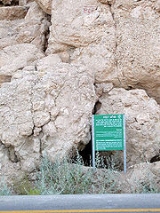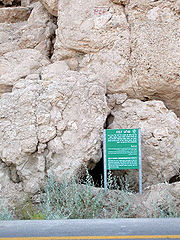
Robert Alexander Stewart Macalister
Encyclopedia
Robert Alexander Stewart Macalister (1870–1950) was an Irish
archaeologist.
Macalister was born in Dublin, Ireland
and studied at Cambridge University. Although his earliest interest was in the archaeology of Ireland, he soon developed a strong interest in biblical archaeology
. Along with Frederick J. Bliss, he excavated several towns in the Shephelah
region of Palestine
from 1898 to 1900. Using advances in stratigraphy
building on the work of Flinders Petrie, they developed a chronology for the region using ceramic
typology
. Upon Bliss' retirement, Macalister became director of excavations for the Palestine Exploration Fund
in 1901.
From 1902 to 1909 he was responsible for the excavations at Gezer
, Palestine
(in the modern nation of Israel
, just west of Jerusalem). This was one of the earliest large-scale scientific archaeological excavations in the region. The Gezer calendar
found there is a very early paleo-Hebrew calendrical inscription. However, in most respects Macalister's work in Palestinian archaeology is considered to have been a failure, due to the poor quality of his excavation techniques and his shoddy record-keeping. Because Macalister was the only professional archaeologist involved in the excavation, managing a project of such complexity was essentially an impossible task.
In 1909 Macalister left the field of Palestinian archaeology to accept a position as professor of Celt
ic archaeology at University College, Dublin, where he taught until his retirement in 1943. During this period, he worked at the ancient Irish royal site of Tara
and was responsible for editing the catalogue of all known ogham
inscriptions from Great Britain
and Ireland
. Many of his translations of Irish myths and legends are still widely used today. He was elected to the Royal Irish Academy
in 1910, and was president of the Royal Society of Antiquaries of Ireland
from 1924 to 1928.

Ireland
Ireland is an island to the northwest of continental Europe. It is the third-largest island in Europe and the twentieth-largest island on Earth...
archaeologist.
Macalister was born in Dublin, Ireland
Ireland
Ireland is an island to the northwest of continental Europe. It is the third-largest island in Europe and the twentieth-largest island on Earth...
and studied at Cambridge University. Although his earliest interest was in the archaeology of Ireland, he soon developed a strong interest in biblical archaeology
Biblical archaeology
For the movement associated with William F. Albright and also known as biblical archaeology, see Biblical archaeology school. For the interpretation of biblical archaeology in relation to biblical historicity, see The Bible and history....
. Along with Frederick J. Bliss, he excavated several towns in the Shephelah
Shephelah
The Shephelah is a designation usually applied to the region in south-central Israel of 10-15 km of low hills between the central Mount Hebron and the coastal plains of Philistia within the area of the Judea, at an altitude of 120-450 metres above sea level. The area is fertile, and a temperate...
region of Palestine
Palestine
Palestine is a conventional name, among others, used to describe the geographic region between the Mediterranean Sea and the Jordan River, and various adjoining lands....
from 1898 to 1900. Using advances in stratigraphy
Stratigraphy
Stratigraphy, a branch of geology, studies rock layers and layering . It is primarily used in the study of sedimentary and layered volcanic rocks....
building on the work of Flinders Petrie, they developed a chronology for the region using ceramic
Ceramic
A ceramic is an inorganic, nonmetallic solid prepared by the action of heat and subsequent cooling. Ceramic materials may have a crystalline or partly crystalline structure, or may be amorphous...
typology
Typology (archaeology)
In archaeology a typology is the result of the classification of things according to their characteristics. The products of the classification, i.e. the classes are also called types. Most archaeological typologies organize artifacts into types, but typologies of houses or roads belonging to a...
. Upon Bliss' retirement, Macalister became director of excavations for the Palestine Exploration Fund
Palestine Exploration Fund
The Palestine Exploration Fund is a British society often simply known as the PEF. It was founded in 1865 and is still functioning today. Its initial object was to carry out surveys of the topography and ethnography of Ottoman Palestine with a remit that fell somewhere between an expeditionary...
in 1901.
From 1902 to 1909 he was responsible for the excavations at Gezer
Gezer
Gezer was a Canaanite city-state and biblical town in ancient Israel. Tel Gezer , an archaeological site midway between Jerusalem and Tel Aviv, is now an Israeli national park....
, Palestine
Palestine
Palestine is a conventional name, among others, used to describe the geographic region between the Mediterranean Sea and the Jordan River, and various adjoining lands....
(in the modern nation of Israel
Israel
The State of Israel is a parliamentary republic located in the Middle East, along the eastern shore of the Mediterranean Sea...
, just west of Jerusalem). This was one of the earliest large-scale scientific archaeological excavations in the region. The Gezer calendar
Gezer calendar
The Gezer calendar is a tablet of soft limestone inscription, dating to the 10th century BCE. Scholars are divided as to whether the script and language are Phoenician or paleo-Hebrew, which were linguistically very similar in this period....
found there is a very early paleo-Hebrew calendrical inscription. However, in most respects Macalister's work in Palestinian archaeology is considered to have been a failure, due to the poor quality of his excavation techniques and his shoddy record-keeping. Because Macalister was the only professional archaeologist involved in the excavation, managing a project of such complexity was essentially an impossible task.
In 1909 Macalister left the field of Palestinian archaeology to accept a position as professor of Celt
Celt
The Celts were a diverse group of tribal societies in Iron Age and Roman-era Europe who spoke Celtic languages.The earliest archaeological culture commonly accepted as Celtic, or rather Proto-Celtic, was the central European Hallstatt culture , named for the rich grave finds in Hallstatt, Austria....
ic archaeology at University College, Dublin, where he taught until his retirement in 1943. During this period, he worked at the ancient Irish royal site of Tara
Hill of Tara
The Hill of Tara , located near the River Boyne, is an archaeological complex that runs between Navan and Dunshaughlin in County Meath, Leinster, Ireland...
and was responsible for editing the catalogue of all known ogham
Ogham
Ogham is an Early Medieval alphabet used primarily to write the Old Irish language, and occasionally the Brythonic language. Ogham is sometimes called the "Celtic Tree Alphabet", based on a High Medieval Bríatharogam tradition ascribing names of trees to the individual letters.There are roughly...
inscriptions from Great Britain
Great Britain
Great Britain or Britain is an island situated to the northwest of Continental Europe. It is the ninth largest island in the world, and the largest European island, as well as the largest of the British Isles...
and Ireland
Ireland
Ireland is an island to the northwest of continental Europe. It is the third-largest island in Europe and the twentieth-largest island on Earth...
. Many of his translations of Irish myths and legends are still widely used today. He was elected to the Royal Irish Academy
Royal Irish Academy
The Royal Irish Academy , based in Dublin, is an all-Ireland, independent, academic body that promotes study and excellence in the sciences, humanities and social sciences. It is one of Ireland's premier learned societies and cultural institutions and currently has around 420 Members, elected in...
in 1910, and was president of the Royal Society of Antiquaries of Ireland
Royal Society of Antiquaries of Ireland
The Royal Society of Antiquaries of Ireland is a learned society based in Ireland, whose aims are 'to preserve, examine and illustrate all ancient monuments and memorials of the arts, manners and customs of the past, as connected with the antiquities, language, literature and history of Ireland'. ...
from 1924 to 1928.
Works

- Ecclesiastical Vestments: Their Development and History (1896) (Internet Archive)
- Studies in Irish Epigraphy (1897) (Google Books (fragmentary))
- Excavations in Palestine, 1898-1900 (1902) (with F.J. Bliss)
- The Story of the Crop-Eared Boy / The Story of the Eagle-Boy (1908) (editor/translator) (Internet Archive)
- The Memorial Slabs of Clonmacnois, King's County (1909) (Internet Archive)
- The Excavation of Gezer (1910–1912)
- A History of Civilization in Palestine (1912) (Internet Archive (1921))
- The Philistines: Their History and Civilization (the Schweich LectureSchweich Lectures on Biblical ArchaeologyThe Schweich Lectures on Biblical Archaeology are a series of lectures delivered and published under the auspices of the British Academy. The Leopold Schweich Trust Fund, set up in 1907, was a gift from Miss Constance Schweich in memory of her father...
for 1911) (Internet Archive) - Muiredach, abbot of Monasterboice, 890-923 A. D.; his life and surroundings (1914) (Internet Archive)
- Temair Breg: a study of the remains and traditions of Tara (1919) (Internet Archive)
- A Text Book of European Archaeology (1921) (Internet Archive)
- The Latin and Irish Lives of Ciaran (1921) (editor/translator) (Internet Archive)
- Ireland in Pre-Celtic Times (1921) (Internet Archive)
- A Century of Excavation in Palestine (1925)
- Excavations on the Hill of Ophel (1926)
- The Archaeology of Ireland (1928)
- Tara, a Pagan Sanctuary of Ancient Ireland (1931)
- Ancient Ireland (1935)
- Lebor Gabála Érenn (1938–1941) (editor/translator) (Internet Archive: Vol. 1, Vol. 3, Vol. 4)
- Corpus Inscriptionum Insularum Celticarum (1945)
See also
- Gezer calendarGezer calendarThe Gezer calendar is a tablet of soft limestone inscription, dating to the 10th century BCE. Scholars are divided as to whether the script and language are Phoenician or paleo-Hebrew, which were linguistically very similar in this period....
- OghamOghamOgham is an Early Medieval alphabet used primarily to write the Old Irish language, and occasionally the Brythonic language. Ogham is sometimes called the "Celtic Tree Alphabet", based on a High Medieval Bríatharogam tradition ascribing names of trees to the individual letters.There are roughly...
- Lebor Gabála ÉrennLebor Gabála ÉrennLebor Gabála Érenn is the Middle Irish title of a loose collection of poems and prose narratives recounting the mythical origins and history of the Irish from the creation of the world down to the Middle Ages...
- Royal Society of Antiquaries of IrelandRoyal Society of Antiquaries of IrelandThe Royal Society of Antiquaries of Ireland is a learned society based in Ireland, whose aims are 'to preserve, examine and illustrate all ancient monuments and memorials of the arts, manners and customs of the past, as connected with the antiquities, language, literature and history of Ireland'. ...
Sources
- Thomas, Page A. 1984. "BA" portrait: The Success and Failure of Robert Alexander Stewart Macalister. Biblical Archaeologist 47(1): 33-35.

